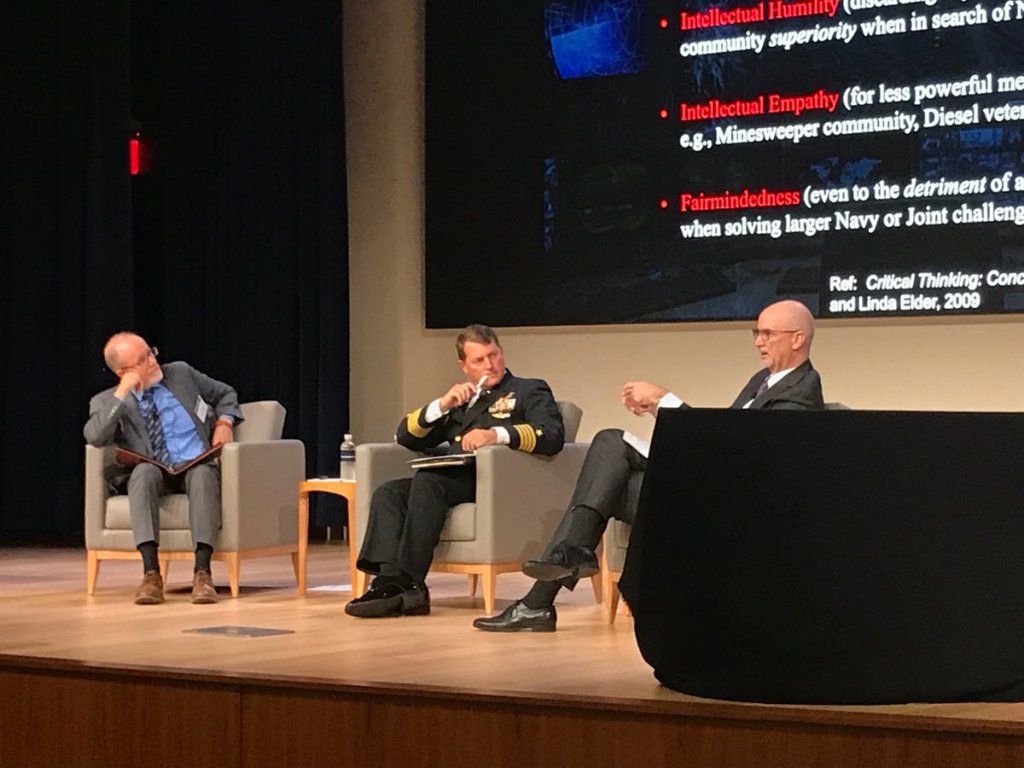These are my remarks from the Naval Institute’s Critical Thinking Conference on 25 October 2023.

A century ago, the Navy created a learning system capable of systematically introducing new tactics, doctrines, and operational concepts. That learning system was the result of a cognitive revolution that began in the late nineteenth century. That revolution had several components:
- At the Naval War College, Alfred Thayer Mahan introduced an educational approach based on theoretical principles that were applicable regardless of changes in tactics and technology. This prompted naval officers to think critically about how best to apply those principles.
- The laws governing naval personnel changed, in 1899 when the line officers and engineering corps were amalgamated, and again in 1916 with the introduction of merit-based promotion. This created a cadre of young officers trained to think systematically who were motivated to showcase their talents.
- The Navy introduced a phased educational system designed to promote continual learning and prepare officers for the challenges they would face at various levels of command during their career.
- And finally, the Office of the Chief of Naval Operations (OPNAV) was created in 1915. This gave the Navy something it had never had before, a staff organization that could think critically about future war and how best to prepare for it.
OPNAV introduced the structure that made the learning system work—the annual exercises, like the Fleet Problems and competitions in engineering and gunnery. Throughout the 1920s and 30s, these provided a means for officers to think critically, apply theoretical principles to specific contexts, and demonstrate their skill. Top-down direction focused energy on the most critical challenges—those involved in a Pacific War—and innovative ideas emerged from the bottom up. After testing and refinement in exercises, the best ideas became the basis for future practice and doctrine.
The result was continual improvement. Tactics, doctrine, and understanding of how best to fight a Pacific war all became increasingly sophisticated in the 1920s and 1930s. The Navy learned how to fight with aircraft carriers, developed more flexible tactics for major fleet action, refined its approach to night combat, and devised new concepts for amphibious warfare. The Navy also integrated new technologies, like high-frequency direction finding, radar, and very high frequency radio. As a result, the Navy of 1941 was much more capable than that of 1918 and a major reason was the fact that officers had been habituated to think critically and problem-solve, both as individuals and as a team.
Admiral Chester Nimitz, who assumed command of the Pacific Fleet after the raid on Pearl Harbor, began to exploit this capability immediately. He turned his staff into a collaborative sensemaking organization. Within the staff, critical thinking became a group activity. Nimitz held conferences every morning to review the current state of the war, broaden situational awareness, and discuss what the latest developments might mean. This process—tempered by Nimitz’s determined aggressiveness—led to the rapid identification of opportunities early in the war. Nimitz and his staff were open to the potential that the cryptologic work of Station Hypo provided and ready to exploit it, leading to strategic victories at the battles of Coral Sea and Midway in mid-1942.
Later in the war, Nimitz and his subordinates continued to leverage the Navy’s learning system. In wartime, of course, the feedback mechanism changed; combat against the Japanese replaced peacetime exercises. Learning took place on multiple levels. In the combat zone, officers experimented with new tactics and techniques. Type commands reviewed lessons, identified approaches that worked best, and issued revised doctrines. At the fleet level, Nimitz and his staff focused on broader themes. The effective synergy between top-down direction and bottom-up innovation continued. It led to the combat information center (CIC), a new flexible playbook for fleet tactics, and a transformational approach to theater logistics.
These improvements were necessary. By mid-1943, the challenge confronting Nimitz and his staff was how to execute a Central Pacific offensive of unprecedented speed and power. He was given the objective of winning the war in just two years, which many reasonable planners felt was an impossible task. Fortunately, Mahan’s principles, which Nimitz and his peers embraced, emphasized the contingent nature of warfare. Opportunities—if created and seized—could hasten the end of the war.
Accordingly, Nimitz and his planners created a campaign plan built as a series of options. Coupled with a revolutionary approach to amphibious assault and the fleet’s new capabilities, the explicit use of options allowed Nimitz to make most effective use of the nation’s industrial potential and translate it into battlefield success. From the start of the offensive at the Gilbert Islands in November 1943 until the invasion of Leyte in October 1944—some six months ahead of schedule—Nimitz remained inside the Japanese decision cycle, keeping them off balance and nullifying their defensive strategies. After Leyte, with less room to maneuver, Nimitz had fewer options, by then so did the Japanese.
That mattered. The evidence shows that without the Navy’s learning system, the war in the Pacific would have taken longer and might have ended under terms far less favorable to the United States. Japan would have fought longer and might have secured a negotiated peace. Alternatively, it might have been divided like Germany, with a substantial portion under Soviet influence. The Navy’s learning system had results on the battlefield, tactically and operationally. The lesson for today is that we would be well-served to create something similar, not identical, but based on the same concepts: recognition that war is inherently contingent, top-down direction to focus creative energy, bottom-up innovation that stimulates the initiative of junior officers, and continual improvement, not just of the Navy but of the the minds of officers and sailors that are its heart.